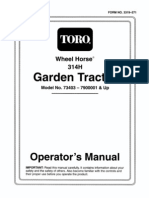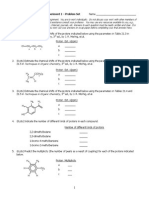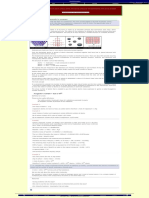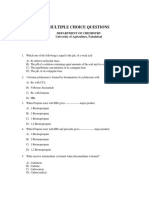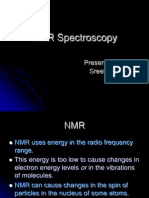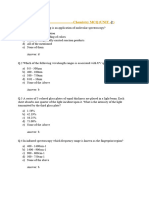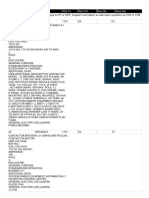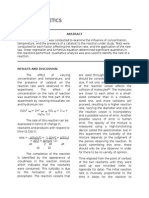Spectrum
Spectrum
Uploaded by
Bashir Dar100%(1)100% found this document useful (1 vote)
223 views4 pagesThis document contains 24 multiple choice questions about UV-visible spectroscopy and infrared spectroscopy. UV-vis spectroscopy can be used to measure conjugation, differentiate between conjugate and non-conjugate bonds, and identify unknown compounds. The Beer-Lambert law relates absorption and concentration. IR spectroscopy is used to determine molecular structure through vibrational transitions and provides a fingerprint region for compound identification. Both techniques have applications in quantitative analysis and determining structural features.
Original Description:
Mcq
Original Title
spectrum
Copyright
© © All Rights Reserved
Available Formats
DOCX, PDF, TXT or read online from Scribd
Share this document
Did you find this document useful?
Is this content inappropriate?
Report this DocumentThis document contains 24 multiple choice questions about UV-visible spectroscopy and infrared spectroscopy. UV-vis spectroscopy can be used to measure conjugation, differentiate between conjugate and non-conjugate bonds, and identify unknown compounds. The Beer-Lambert law relates absorption and concentration. IR spectroscopy is used to determine molecular structure through vibrational transitions and provides a fingerprint region for compound identification. Both techniques have applications in quantitative analysis and determining structural features.
Copyright:
© All Rights Reserved
Available Formats
Download as DOCX, PDF, TXT or read online from Scribd
Download as docx, pdf, or txt
100%(1)100% found this document useful (1 vote)
223 views4 pagesSpectrum
Spectrum
Uploaded by
Bashir DarThis document contains 24 multiple choice questions about UV-visible spectroscopy and infrared spectroscopy. UV-vis spectroscopy can be used to measure conjugation, differentiate between conjugate and non-conjugate bonds, and identify unknown compounds. The Beer-Lambert law relates absorption and concentration. IR spectroscopy is used to determine molecular structure through vibrational transitions and provides a fingerprint region for compound identification. Both techniques have applications in quantitative analysis and determining structural features.
Copyright:
© All Rights Reserved
Available Formats
Download as DOCX, PDF, TXT or read online from Scribd
Download as docx, pdf, or txt
You are on page 1of 4
Q no 1: UV spectroscopy is used to measure the
a) No of conjugate bonds b) Diffrentiate between conjugate & non conjugate bonds
c) Aromatic conjugation with molecules d) All
Ans: All
Q no 2: Units of absorbance are
a) dm³ mol⁻¹ cm⁻¹ b) Dimensionless c)mol dm⁻³ d)cm
Ans: Dimensionless
Q no 3: Beer‒Lambert law gives the relation between which of the following
a) Reflected radiation & concentration b) Scattered radiation & concentration
c) Energy absorption & concentration d) Energy absorption & reflected radiation
Ans: Energy absorption & concentration
Q no 4: Lambert’s law states that the intensity of light decreases with respect to
a) Concentration b) Volume c) Distance d) Composition
Ans: Distance
Q no 5: Which of the following is not true about absorption spectroscopy
a) It involves transmission b) Scattering is kept minimum
c) Reflection is kept maximum d) Intensity of radiation leaving the substance is an indication of
concentration
Ans: Reflection is kept maximum
Q no 6: Ordinary spectrometers cover a range of
a) 200‒400 nm b) 220‒800 nm c) 400‒800 nm d) 350‒700 nm
Ans: 220‒800 nm
Q no 7: Red shift is also called as
a) Bathochromic shift b) hypsochromic shift c) hypochromic shift d) Hyperchromic shift
Ans Bathochromic shift
Q no 8: R‒ Bands arise due to
a) n‒π* b) π‒π* c)σ ‒π* d) σ‒σ*
Ans: n‒π*
Q no 9: Which of the following is application of UV spectroscopy
a) Extent of conjugation b) determination of geometrical isomerism
c) Identification of unknown compound d) All
Ans: All
Q no 10: Quantitative analysis is based on
a) Beer’s law b) Lambert’s law c) Beer‒ lambert law d) None
Ans: Beer‒ lambert law
Q no 11: Spectroscopy used for the determination of structure of a compound using vibrational
transistions
a)IR b) UV c) Visible d) Microwave
Ans: IR
Qno 12: The IR region of electromagnetic radiation spectrum extends from
a) 0.3‒200μ b) 0.8 ‒200μ c) 0.4‒300μ d) 0.1‒100μ
Ans: 0.8‒200μ
Q no13: The order of energies for various transistions is
a) n‒σ* >π‒σ*>σ‒σ*>π‒π* b)σ‒σ*>n‒σ*>π‒π*>n‒π* c) σ‒σ*<n‒σ*<π‒π*<n‒π* d)
n‒π*<π‒π*<σ‒π*<n‒σ*
Ans: σ‒σ*>n‒σ*>π‒π*>n‒π*
No 14: Allowed transistions with values of extinction coefficient є max more than generally arise due
to
a) π‒π* transistions b)σ‒σ* transistions c) n‒π* transistions d) n‒σ* transistions
Ans: π‒π* transistions
Q no 15: Which of the following shows both types of transistions both allowed & forbidden
a) Benzophenone b) cyclopentonone cHexene d) None
Ans: benzophenone
Q no 16 : Groups which distort the geometry of molecules cause
a) bathochromic shift b)Hypsochromic shift c) Hypochrmic shift d) Hyperchromic shift
Ans: Bathochromic shift
Q no 17: molecular vibrations are detected & measured in
a) 2.5μ to 15μ b) 2.4μ to 20μ c) 4.2μ to 80μ d) 5.2 μ to 40μ
Ans: 2.5μ to 15μ
Q no 18: Which of the following provides finger print region
a) UV b) IR c) Microwave d) ALL
Ans: IR
Qno 19: In which of the following bond angle changes
a) Strecthing b) Bending c) twisting d) None
Ans: Twisting
QNo 20: Which of the following is IR inactive
a) H₂ b) N₂ c) O₂ d)All
Ans: All
Q no 21: Absorbed band of hexane comes in
a) 1713 cm⁻¹ b) 1709 cm⁻¹ c)1726 cm⁻¹ d) 1728 cm⁻¹
Ans: 1726 cm⁻¹
Q no 22: Prism used to obtain monochromatic light is made of
a) Glass b) NaCl c) CaCl ₂ d) None
Ans: Nacl
Q no 23: Solvents used for IR are
a) Chlorofom b) Carbontetrachloride c) Carbondisulphide d) All
Ans: All
Q no24: Position of IR bands of chelate compounds is
a) 2300‒3200 cm⁻¹ b) 2500‒3000 cm⁻¹ c) 2500‒ 3200 cm⁻¹ d) 2200‒3000 cm⁻¹
Ans: 2500‒3200 cm⁻¹
You might also like
- WheelHorse 314-H Operators Manual 73403Document44 pagesWheelHorse 314-H Operators Manual 73403Kevins Small Engine and Tractor Service100% (2)
- Huatech Brief Catalogue-2022 PDFDocument44 pagesHuatech Brief Catalogue-2022 PDF萧HuatechNo ratings yet
- Question Bank On Ir Spectroscopy-MatDocument10 pagesQuestion Bank On Ir Spectroscopy-MatRohan Sharma50% (4)
- 1H NMR Problem SetDocument5 pages1H NMR Problem Setfishfeeder1No ratings yet
- NMR 1Document3 pagesNMR 1amitNo ratings yet
- CH 135 Exam II A KeyDocument6 pagesCH 135 Exam II A KeyMark Cliffton BadlonNo ratings yet
- GC MSDocument53 pagesGC MSNaresh Kumar Marx50% (2)
- Experiment 8: Reduction of 4-T-Butylcyclohexanone With Sodium BorohydrideDocument7 pagesExperiment 8: Reduction of 4-T-Butylcyclohexanone With Sodium BorohydrideNorazma ZainuddinNo ratings yet
- WEG Ssw07 Manual Do Usuario 0899.5832 Manual Portugues BRDocument162 pagesWEG Ssw07 Manual Do Usuario 0899.5832 Manual Portugues BRDanilo CarvalhoNo ratings yet
- Hrushikesh Organic Group 5Document10 pagesHrushikesh Organic Group 5Sarita YadavNo ratings yet
- MSC 2 Mcqs Analytical Chemistry MSC 2ndDocument20 pagesMSC 2 Mcqs Analytical Chemistry MSC 2ndPhoton Online Science AcademyNo ratings yet
- Problem Set 13 and 14Document6 pagesProblem Set 13 and 14sophia del rosario100% (1)
- Absorption Laws (Quantitative Analysis)Document15 pagesAbsorption Laws (Quantitative Analysis)Belay HaileNo ratings yet
- A. Absorption: B. Elution C. A and B D. None of ThisDocument7 pagesA. Absorption: B. Elution C. A and B D. None of ThisTRÂN NGUYỄN NGỌC BẢONo ratings yet
- Analytical Sem 6, Practice MCQ'sDocument9 pagesAnalytical Sem 6, Practice MCQ'sanooshNo ratings yet
- Assignment of Van-Deemter Plots Submitted by Group No. 8Document6 pagesAssignment of Van-Deemter Plots Submitted by Group No. 8Muhammad AhmedNo ratings yet
- MCQ On PoentiometryDocument4 pagesMCQ On Poentiometrygehanhefina804No ratings yet
- Gate Test Series 4 ChemistryDocument14 pagesGate Test Series 4 ChemistryRaja kumarNo ratings yet
- ELECTROCHEMISTRYDocument153 pagesELECTROCHEMISTRYSTUDY GRINDNo ratings yet
- Chemical Kinetics Study Material & QuestionsDocument26 pagesChemical Kinetics Study Material & QuestionsKRITHIKA .MNo ratings yet
- Polyethylene (PE) MCQsDocument12 pagesPolyethylene (PE) MCQsSHUBHRAJITNo ratings yet
- CH301 Tutorial Solutions On IR Spectros PDFDocument4 pagesCH301 Tutorial Solutions On IR Spectros PDFArjun MaharajNo ratings yet
- Nuclear Magnetic Resonance SpectrosDocument11 pagesNuclear Magnetic Resonance Spectrosilias1973No ratings yet
- Pharm Analysis III Sem 7 CBCS Practise MCQsDocument5 pagesPharm Analysis III Sem 7 CBCS Practise MCQsKhadija HameedNo ratings yet
- Physical CHM MCQS For MSCDocument15 pagesPhysical CHM MCQS For MSCPhoton Online Science AcademyNo ratings yet
- Aromaticity: Aromaticity: Benzenoid and Non-Benzenoid Compounds - Generation and ReactionsDocument7 pagesAromaticity: Aromaticity: Benzenoid and Non-Benzenoid Compounds - Generation and ReactionsSankar AdhikariNo ratings yet
- CoulometryDocument22 pagesCoulometryElton Boholst100% (1)
- PRACTICE MCQ HYDROCARBONS - 11ScADocument7 pagesPRACTICE MCQ HYDROCARBONS - 11ScAArda Rahmaini100% (1)
- Errors in Chemical AnalysisDocument21 pagesErrors in Chemical AnalysisIshrat YaqoobNo ratings yet
- IB Chemistry Notes - Stoichiometry and The Mole ConceptDocument1 pageIB Chemistry Notes - Stoichiometry and The Mole ConceptKefin TajebNo ratings yet
- MCQ Chapter 2 ElectrochemistryDocument4 pagesMCQ Chapter 2 ElectrochemistrySavien BrandanNo ratings yet
- SpectrosDocument71 pagesSpectrosAfifah SabriNo ratings yet
- Chem Academy: NMR SpectrosDocument1 pageChem Academy: NMR SpectrosSandipan SahaNo ratings yet
- Een Chemistry & Nano ChemistryDocument12 pagesEen Chemistry & Nano ChemistrySuyog Tekam100% (1)
- Harris QCA 8e Chapter 17 NewDocument2 pagesHarris QCA 8e Chapter 17 NewClarisse WongNo ratings yet
- MCQ For Test Final 26-11-15Document4 pagesMCQ For Test Final 26-11-15Aamir NaweedNo ratings yet
- Atomic Spectra: AnswerDocument2 pagesAtomic Spectra: Answerabdul mananNo ratings yet
- 1000 Mcqs ChemistryDocument113 pages1000 Mcqs ChemistryMariam IshtiaqNo ratings yet
- ITA Viva - Questions OnlyDocument4 pagesITA Viva - Questions OnlyManoj KhanalNo ratings yet
- Atomic Structure and Spectra: Selection RulesDocument51 pagesAtomic Structure and Spectra: Selection RulesAdministracion OTIC IVICNo ratings yet
- Bpharm 7 Sem Pharmaceutical Analysis and Quality Assurance Bop 475 2018 19Document2 pagesBpharm 7 Sem Pharmaceutical Analysis and Quality Assurance Bop 475 2018 19Bharti sain100% (1)
- LS - 0 - 2 - 2d3125 - 024b00625d276-Statistical ThermodynamicsDocument8 pagesLS - 0 - 2 - 2d3125 - 024b00625d276-Statistical ThermodynamicsHamit RanaNo ratings yet
- Answer: (A) and (B)Document18 pagesAnswer: (A) and (B)Germaine Manangan100% (1)
- Exam1 04Document7 pagesExam1 04Rodney SalazarNo ratings yet
- Chapter 15Document27 pagesChapter 15anastark100% (6)
- NMR SpectrosDocument29 pagesNMR Spectroshareesh13h100% (1)
- D-Block Elements (Q.B.) 12THDocument4 pagesD-Block Elements (Q.B.) 12THRaju SinghNo ratings yet
- Iit Questions On Carbonyl Compounds & Carboxylic Acid and Its DerivativeDocument12 pagesIit Questions On Carbonyl Compounds & Carboxylic Acid and Its DerivativeRaju SinghNo ratings yet
- M.Sc. 3 Semester Multiple Choice QuestionsDocument56 pagesM.Sc. 3 Semester Multiple Choice QuestionsChaudary Zain Ul AbideenNo ratings yet
- Nuclear Chemistry: Unit 11Document15 pagesNuclear Chemistry: Unit 11Suryansh SrivastavaNo ratings yet
- Woodward HoffmannDocument80 pagesWoodward HoffmannChemistry MESNo ratings yet
- Question On Chemical Kinetics-MA 2022Document12 pagesQuestion On Chemical Kinetics-MA 2022Sangay ChodenNo ratings yet
- Acid Base SolutionsDocument10 pagesAcid Base SolutionsCasey SangalliNo ratings yet
- Final ExamDocument11 pagesFinal Exammalak hilalNo ratings yet
- Instrumentation and Computer Aided Analysis Multiple Choice Question (Gurukpo)Document7 pagesInstrumentation and Computer Aided Analysis Multiple Choice Question (Gurukpo)GuruKPO100% (2)
- LS - 0 - 2 - 2d3125 - 0246d18b52c60-Group TheoryDocument2 pagesLS - 0 - 2 - 2d3125 - 0246d18b52c60-Group TheoryHamit RanaNo ratings yet
- Electrochemistry - DPP 04Document2 pagesElectrochemistry - DPP 04MehulNo ratings yet
- Question Bank - Sem - III - TYBSC Chemistry Paper - II (Inorganic Chemistry)Document8 pagesQuestion Bank - Sem - III - TYBSC Chemistry Paper - II (Inorganic Chemistry)Nirmal PatilNo ratings yet
- Unit 10 - Week 9: Assignment 9Document5 pagesUnit 10 - Week 9: Assignment 9UmaNo ratings yet
- MCQ On Mass Spectroscopy: Sarita Lalji Yadav Roll No-26 Msc-I Organic ChemistryDocument3 pagesMCQ On Mass Spectroscopy: Sarita Lalji Yadav Roll No-26 Msc-I Organic ChemistrySarita YadavNo ratings yet
- Aromatic Hydrocarbon (Q.B.) (MSC)Document14 pagesAromatic Hydrocarbon (Q.B.) (MSC)Raj ModiNo ratings yet
- Chemistry Unit 2 MCQ With AnswersDocument5 pagesChemistry Unit 2 MCQ With AnswersKaran Vaswani100% (2)
- MCQ Test-4, Unit 2, Engg - Chemistry, 2020-21Document10 pagesMCQ Test-4, Unit 2, Engg - Chemistry, 2020-21Dr. N. P. Tripathi100% (1)
- Allyl ADocument5 pagesAllyl AAhmed AliNo ratings yet
- EN 1822 2009 Clasificacion Filtros PDFDocument2 pagesEN 1822 2009 Clasificacion Filtros PDFMiguel Angel Pacahuala CristobalNo ratings yet
- Front Side Member (Cut-P) : With The Radiator Side Support RemovedDocument5 pagesFront Side Member (Cut-P) : With The Radiator Side Support RemovedThiện NguyênNo ratings yet
- Load Cells and Load Application Elements: Project Planning / Installation / ServiceDocument70 pagesLoad Cells and Load Application Elements: Project Planning / Installation / ServiceArturMirandaNo ratings yet
- 19-Masganti - Sample Preparation For Peat Material AnalysisDocument6 pages19-Masganti - Sample Preparation For Peat Material Analysismerek12No ratings yet
- Hancock Type 4000 yDocument8 pagesHancock Type 4000 yGohilakrishnan ThiagarajanNo ratings yet
- Assignment-M2 5 GEDDocument2 pagesAssignment-M2 5 GEDdeamon1 santosNo ratings yet
- LT1738Document20 pagesLT1738asminusNo ratings yet
- ICAO Environmental Report 2019 - Chapter 6Document45 pagesICAO Environmental Report 2019 - Chapter 6scorpion2001glaNo ratings yet
- Milan SapkotaDocument4 pagesMilan SapkotaPratikTiwariNo ratings yet
- Work - Energy and Pressure in FluidsDocument7 pagesWork - Energy and Pressure in FluidsNorKamilahMakhtarNo ratings yet
- Work, Energy, and MomentumDocument67 pagesWork, Energy, and MomentumHANNA FRANCESCA CORPUZNo ratings yet
- L5 - Sustainable Building in Hong KongDocument49 pagesL5 - Sustainable Building in Hong Kongsmithson JoeNo ratings yet
- Calculation of KVARDocument15 pagesCalculation of KVARAnshul Jain100% (1)
- Subsurface Ventilation and Environmental Engineering: B.SC., PH.D., C.Eng., Fimine, Fimm, Mem - Aime, Mem - AshraeDocument27 pagesSubsurface Ventilation and Environmental Engineering: B.SC., PH.D., C.Eng., Fimine, Fimm, Mem - Aime, Mem - Ashraesatyabrata beheraNo ratings yet
- Buck & Boost Operation Using Single Phase Matrix ConverterDocument25 pagesBuck & Boost Operation Using Single Phase Matrix ConverterManu JainNo ratings yet
- RFQ13355Document2 pagesRFQ13355Abdulgaffar HawaldarNo ratings yet
- 5134645-Spare Parts Catalog-51994950001-2Document163 pages5134645-Spare Parts Catalog-51994950001-2BobNo ratings yet
- Chemical KineticsDocument4 pagesChemical KineticsSheila Camille OrdoñaNo ratings yet
- Time: 3 Hours Max. Marks: 100Document1 pageTime: 3 Hours Max. Marks: 100Yatheesh KCNo ratings yet
- Peter Atkins Julio de Paula Ron Friedman Physical Chemistry Quanta (0613-0663)Document51 pagesPeter Atkins Julio de Paula Ron Friedman Physical Chemistry Quanta (0613-0663)Administracion OTIC IVICNo ratings yet
- DDDHKDocument24 pagesDDDHKAhmed NabilNo ratings yet
- Basic Electrical Engineering 22EEC01Document2 pagesBasic Electrical Engineering 22EEC01ltsreeram12No ratings yet
- 9 Electrical Equip. Mait - NSQFDocument109 pages9 Electrical Equip. Mait - NSQFajithcapeNo ratings yet
- Sec1 Sci c7p Eq 2nd 61marks 4studentsDocument14 pagesSec1 Sci c7p Eq 2nd 61marks 4studentsKamasha BabaNo ratings yet
- Qbiss Air Brochure SIDocument40 pagesQbiss Air Brochure SIMauricio Senior RamírezNo ratings yet
- Rearrangement ReactionsDocument5 pagesRearrangement Reactionsblue_l1100% (1)
